A beginner's guide to planting almonds in the fall
Almonds are a unique tree. It has an amazing delicate aroma, beautiful pink-white flowers, tasty and healthy nuts. Once the almond tree was grown only in the south, today it has settled in the middle zone of the country. Almonds can be found both in the Krasnodar Territory and in the Leningrad Region or the Moscow Region.
Growing success depends a lot on when and how the plant is planted. In the article, we will consider in detail how to germinate almonds in the open field and how to care for such a tree in your garden.
The content of the article
Is it possible to plant almonds in autumn
Planted almond both in spring and autumn - it all depends on the planting method and the region of cultivation. For autumn planting pits are prepared at the beginning of summer - holes are pulled out and fertilized with organic fertilizers: slurry, wood ash, humus or peat.
Pros and cons of autumn planting
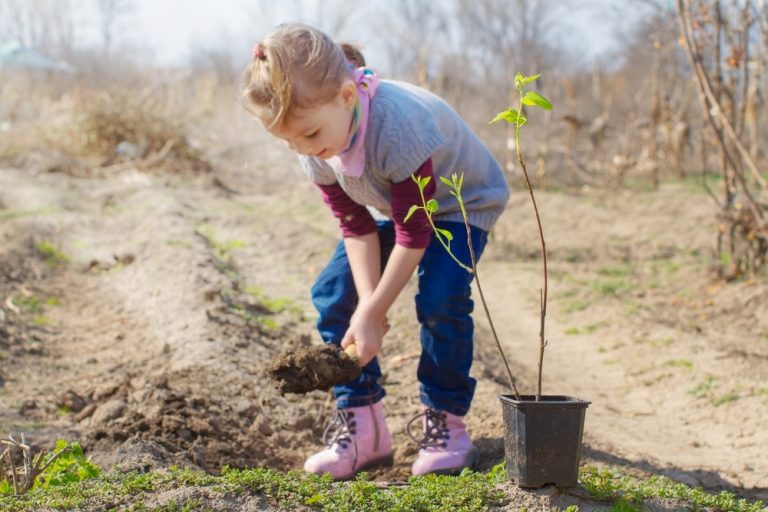
In the fall, seedlings are used for planting. If you take the bones, they will be destroyed by rodents - mice and moles. Also, in the fall, the weather and the humidity level are comfortable for almonds - summer residents will not have to constantly water the plant, as it would be in spring. An autumn seedling will start developing much earlier than a spring one. This is also due to the fact that the earth is already warmed up and has been treated for diseases and insect pests throughout the summer.
Attention! The advantage of planting in autumn is that almond seedlings can be purchased at a good discount. The planting material is etched and immediately placed on the site. It is not necessary to store it in special conditions for 1-2 months, as it happens with a spring planting.
Sometimes the tree grows poorly due to the fact that an infected or damaged planting material was purchased. But this can happen in the spring. Also, problems arise if the seedling is planted too late, and the heat-loving almond is frozen.
Planting dates for almonds in autumn
Planting begins before the rest of the garden trees shed their leaves. In the south of the country it is mid-October, in central Russia - the end of September... In the northern regions (in the Urals and in Siberia), almonds are not grown - the climate for a southern tree is not at all suitable.
An ideal day for the procedure is dry and warm, with a temperature of at least + 10 ° C and an air humidity of 80-85%... There should be no gusty winds, rain or other precipitation. When choosing a date, pay attention to the growing region, climatic conditions. Some gardeners also take into account the lunar calendar - it shows favorable days for agrotechnical procedures.
Seat selection
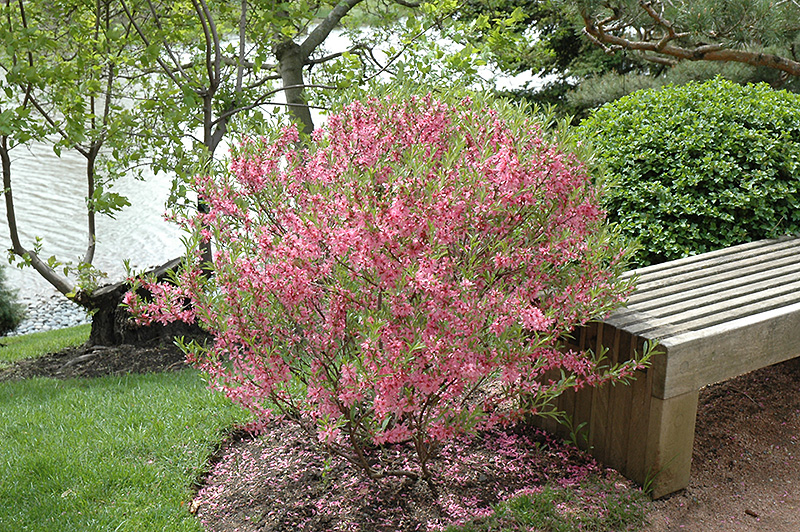
Almonds are a light-loving plant, therefore they are planted in sunny and spacious areas; shade or partial shade is absolutely not suitable. With a lack of light, the development of leaves and flowers slows down, the crown becomes dense - the internal shoots dry out. It is not recommended to grow a southern plant near houses or other garden structures - they obscure the tree and create shade.
The land plot for the almond tree should be located on a hill - this protects the root system from waterlogging and rotting. A high level of groundwater occurrence, due to which almonds are sick with fungal diseases, is unacceptable.There should be no open sources or bodies of water near the tree. Experienced gardeners allocate gentle slopes for seedlings.
Suitable neighbors for the plant are low-growing shrubs, for example, raspberries, black and red currants, irga, gooseberries. Solanaceous or greens are also planted nearby. Unfavorable neighborhood - tall fruit trees: pear, apple, plum, apricot, peach. Plants overshadow each other, which is why they lack sunlight and heat.
It is interesting:
Where and how to store almonds at home, peeled and in shell
Soil preparation
Almonds are undemanding to the type of soil, grows well on light clay, light sandy and even rocky soils. A rich harvest is obtained from plants that are found in nutrient and mineral-rich lands. Heavy clayey soil and soil with a high level of acidity are not suitable for cultivation - pH should be 4.5-7.5, otherwise you can forget about a good harvest.
Landing pit
Weeds are removed from the ground, fallen leaves, dry grass and debris are removed. Before planting, a hole 50 cm deep and 60 cm in diameter is dug in 2-3 months. Organic and mineral components are introduced into it in 3 weeks - 5 kg of rotted manure and 500 g of superphosphate. The pits are filled with soil, which consists of equal parts of turf, purchased and leaf land. To improve the air permeability of the earth, refined river sand is added to it. If the soil is acidic, add chalk or lime - 150 g per 1 sq. m.
At the bottom of the planting pit, a drainage layer of broken brick or rubble is constructed. After that, a long pole is installed in the center of the pit - this is a support for the seedling. The pole must rise above the ground by at least 50 cm.
Attention! It is recommended to grow 3-4 mutually pollinated varieties on a personal plot. The distance between trees is from 3 to 5 m, the distance between rows is 5 m.
Planting material
Planting material is purchased in specialized nurseries. When buying, gardeners always check with the seller if this or that variety is intended for cultivation in a particular region. For example, frost-resistant varieties Primorsky and Dessertny are chosen for the middle lane.
The seedling must have a healthy appearance, without spots, damage, signs of rot. Immediately before planting, the roots are placed in a clay mash. This will protect against possible diseases and help the plant adapt more quickly to new growing conditions.
Planting nuts
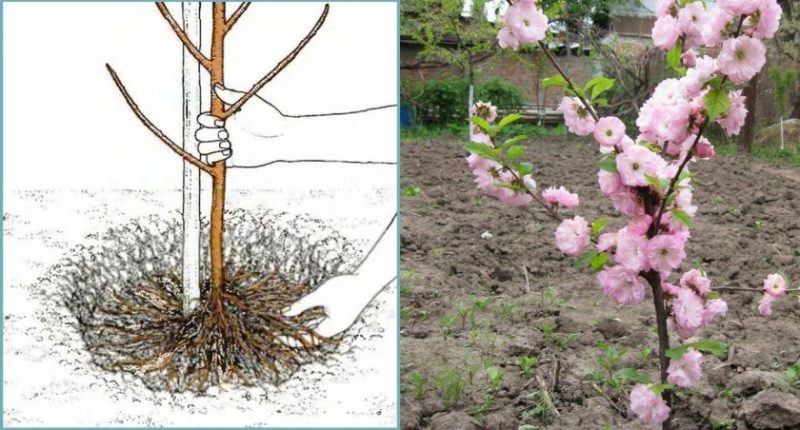
One way to plant an almond tree is to grow it from a nut. To do this, in late spring or summer, dry almonds are prepared peeled from the shell and germinated. A few of the largest nuts are placed in a bowl of clean water at room temperature and left to stand for 10-12 hours. After they are washed, the water is changed and left for another 8 hours. During this time, the nuts swell. Then they should hatch - at this stage the seeds are ready for planting.
They are placed in deep pots with prepared nutrient soil. The seeds are buried 10-12 cm, sprinkled with loose earth and watered abundantly. Almonds are left on a sunny windowsill, periodically watering and fertilizing. The first shoots will appear in 5-6 weeks. As soon as the tree reaches 1 m, it is moved to the site.
How to plant almonds in the fall
In order for almonds to delight with lush and fragrant flowers, and then bring healthy nuts, it is recommended to study the step-by-step instructions. She will help to avoid common mistakes and reveal all the nuances of the procedure.
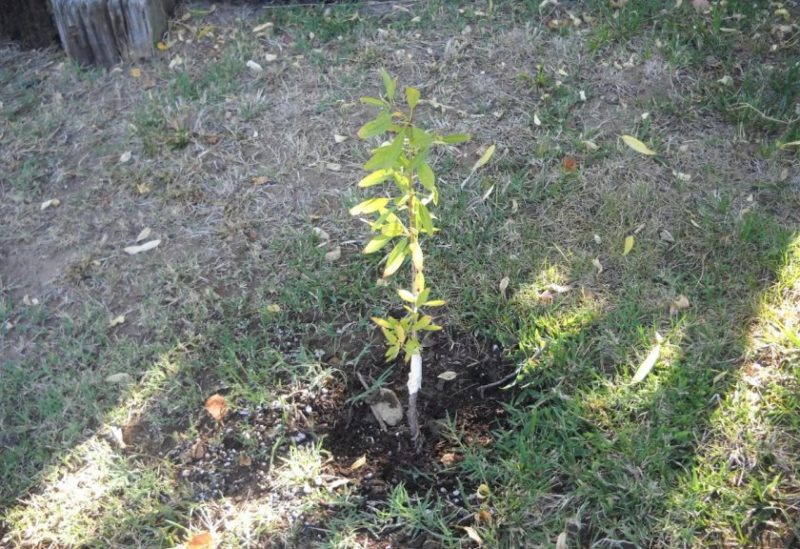
Step-by-step planting instructions
The best time to plant is an early cloudy morning. After the root system of the seedling is lowered into the chatterbox, proceed to the following:
- On top of the laid drainage layer, soil is poured into the pit so that a small hill is obtained.
- A seedling is placed in its center, carefully spreading the roots in different directions.
- The root collar of the plant is placed so that it rises 2-3 cm above the soil surface.
- The pit is densely covered with soil, there should be no voids.
- The earth is tamped and watered with warm water.
- The soil is mulched with peat, sawdust or dry soil. The mulch covers the root collar by 3-4 cm.
- As soon as the earth settles and the liquid is completely absorbed, the seedling is tied to the previously installed support.
Mistakes to Avoid
Almonds will not bear fruit if the root system is damaged during planting, for example, squeezing too much or carelessly spreading thin roots. This leads to the fact that already for 2-3 years the plant is often sick, grows sluggish.
Also, inexperienced gardeners are inattentive to the choice of a planting site - they grow an almond tree near apple trees, pears, a swamp or other body of water. All this also leads to weak immunity and diseases.
The tree grows poorly if you choose the wrong variety or buy a sick and weak seedling. It is not recommended to purchase planting material from unfamiliar sellers. Growing problems also arise due to the fact that the soil is heavy and clayey, with high acidity.
Landing features depending on the region
A prerequisite for growing almond trees in the south is a drainage layer. Otherwise, high temperatures and humidity lead to root diseases, which causes the whole tree to suffer and yield decreases. The materials at hand are used as drainage: broken ceramic dishes, charcoal, moss, foam cubes or ordinary pebbles. Drainage is placed in a pit before planting - first large particles, then medium and small. It is desirable that there are no large voids between them.
When growing almonds in the regions of the middle zone of the country, before planting, the pit is fertilized not only with organic matter, but also with mineral components. It can be 200 g of double superphosphate or 150 g of potassium sulfate. Fertilizer increases the frost resistance of the plant. After such a dressing, the seedlings are not fed for 2 years.
Post-procedure care
Water the almond tree when the soil dries. It is important to ensure that the root collar is not in water, this causes rotting of the seedlings. 10 liters of water are poured under one plant. After each watering, the soil is loosened to a depth of 5-6 cm so that the liquid does not stagnate on the surface and penetrates as deeply as possible. Before the procedure, summer residents remove all weeds and dry grass - this is an ideal breeding ground for insect pests (aphids and spider mites).
In order for the almonds to grow and develop quickly, top dressing is introduced in the spring: mullein infusion or manure, ash or peat. Mineral fertilizers are also suitable - 10 g of ammonium nitrate and 5 g of urea per 5 liters of water. The nutrient solution is poured under the plant. It strengthens the immune system and prevents diseases: bacterial necrosis of the bark, stem rot, burns.
Experienced gardening tips
Planting an almond tree is standard, similar to planting other garden trees. The advice of experienced gardeners will help you get a rich harvest: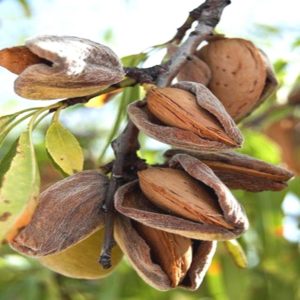
- plant in well-lit areas away from groundwater;
- pre-fertilize the pit with mullein or slurry;
- prepare a drainage layer;
- before planting, place the seedling in a clay talker;
- observe the rules of the neighborhood and the spacing between plants;
- plant almonds before autumn leaves;
- do not forget about the support in the form of a pole or stick;
- water with clean water as the soil dries;
- in the second year after planting, carry out formative pruning.
Conclusion
Autumn is the perfect time to plant almonds. More often it is grown from a seedling, less often from nuts. For planting, a pit 60 cm deep is prepared and fertilized with organic matter, laying a drainage layer of pebbles or broken brick on the bottom. The seedling is placed in a hole and sprinkled with earth, then tied to a support.The plant is planted in sunny areas with light sandy or clay soils. There should be no other fruit trees or tall buildings nearby. After planting, the plant is watered and mulched.